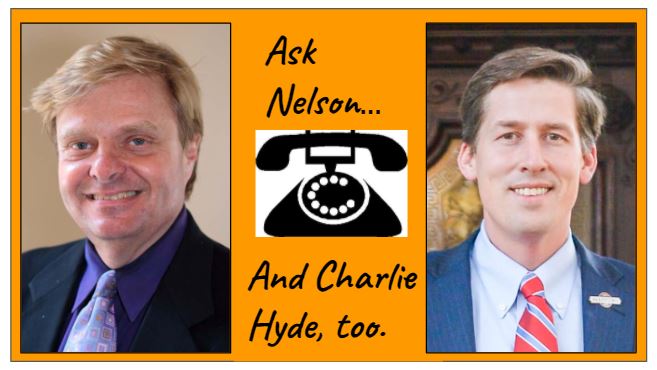Saturdays, noon to 1 p.m. ET on WICR 88.7 FM.
Or stream audio live from anywhere on WICR Online!
February 13, 2021
A distinctive cemetery and efforts to humanize former Central State patients
Click here to listen to the podcast.
Since our show in 2019 about the Indiana Medical History Museum, news has unfolded related to the museum, which is housed in a building that was part of the historic campus of the former Central State Hospital, a psychiatric facility in Indianapolis that closed in 1994.
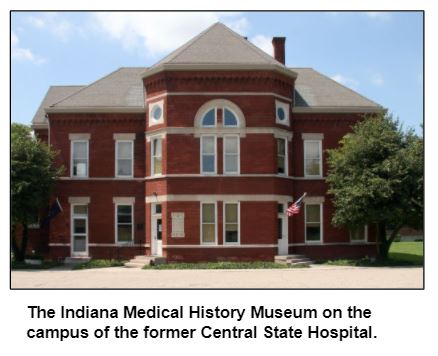
When Sarah Halter, executive director of the museum, is Nelson's guest, she will provide updates about the cemetery project. Some aspects have been resolved, according to Sarah.
The remains of the patients affected by the utility work have been carefully exhumed by archaeologists and will be reinterred elsewhere. But other aspects of the museum's cemetery initiatives have yet to reach a resolution. The cemetery is on land owned by the city and used by the police department for its horse patrol.
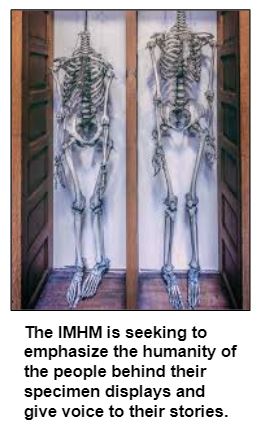
They include, she says, "a new, permanent re-interpretation of our specimen collection that emphasizes the humanity of these specimens and tells the stories of the people from whom they came."
In addition to the museum's exhibits conveying the stories of patients at Central State, many of the personal stories now can be viewed online, with new accounts added periodically.
"We hope that these projects will not only re-humanize the patients, who were too often left out of the story, but also combat stigma and foster compassion and respect for all people, past and present, who experience mental health issues," Sarah says.
The museum is housed in a brick structure once known as the Old Pathology Building. During the 1890s, brain research considered groundbreaking for its era was conducted in clinical labs in the building, which also had an autopsy room and an amphitheater for lectures to medical students.
During our show, Sarah will describe the development underway of a project called Voices from Central State. Designed to be a "memory archive/forum," it will serve as an online platform for people with a range of connections to Central State to share stories and photos as well as engage in discussion.
History Mystery
Before Crown Hill Cemetery in Indianapolis was created during the 1860s, the largest graveyard in the city was located near the White River. The pioneer cemetery was prone to flooding, a significant factor in the decision by civic leaders to create Crown Hill on much higher ground. It was dedicated in 1864.
During subsequent years, many Hoosiers who had been buried at the city's first major cemetery were exhumed and reburied at Crown Hill.
Question: What was the name of the first major cemetery in Indianapolis?
The call-in number is (317) 788-3314. Please do not call in to the show until you hear Nelson pose the question on the air, and please do not try to win if you have won any other prize on WICR during the last two months. You must be willing to give your first name to our engineer, you must answer the question correctly on the air and you must be willing to give your mailing address to our engineer so we can mail the prize pack to you.The prizes this week are two tickets to the Indiana Medical History Museum, courtesy of the Indiana Medical History Museum, and two tickets to the Seiberling Mansion in Kokomo, courtesy of Howard County Historical Society and Peggy Hollingsworth.
Hoosier History Live salutes broadcast journalist Jill Ditmire, 1964-2021
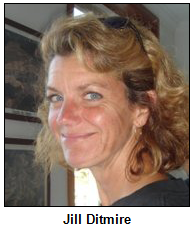 The recent death of veteran central Indiana journalist and arts and wine enthusiast Jill Ditmire saddens us all.
The recent death of veteran central Indiana journalist and arts and wine enthusiast Jill Ditmire saddens us all.
Jill called herself an "OmniMedia Specialist," and she shared her bubbly wit, talent, and knowledge pretty much everywhere: WFYI, WICR, Indianapolis Star and Village Sampler were just a few of the media outlets to which she lent her abundant expertise.
Jill was occasionally a part of the Hoosier History Live team as well, both as guest host and as co-host with Nelson Price on a 2013 show titled Wine Heritage in Indiana. Their guests were Richard Vine, a professor emeritus at Purdue University specializing in enology (that's the study and making of wine), along with Mark Easley of Easley Winery in downtown Indianapolis.
And if the Hoosier state seems like an odd place to specialize in wine, recall that America's first commercially successful winery was in Switzerland County in the small town of Vineyard, which now exists only on antiquated maps of southeastern Indiana.
Jill was also a regular talent on another Molly Head-produced show that aired on WICR. Too Many Cooks! was a food, cooking and wine show that featured Jill as a call-in wine reporter known by fans as the "Wine Maven." Other show talents included Patti Denton, Gary BraVard and Jo Ellen Meyers Sharp.
Her obituary and other information are available here.
Nelson Price, host and historian
Molly Head, producer/general manager, (317) 927-9101
Mick Armbruster, associate producer
Cheryl Lamb, administrative manager
Richard Sullivan, senior tech consultant
Pam Fraizer, graphic designer
Garry Chilluffo, consultant
Please tell our sponsors that you appreciate their support!

 For organizational sponsorship, which includes logos, links, and voiced credits in the show and in podcasts, email molly@hoosierhistorylive.org, or call (317) 927-9101 for information. Our podcast listens are increasing and we are being distributed on Indiana Memory and the National Digital Public Library. Grow with us as our podcast and internet presence expands! Thanks also to Visit Indy, Fraizer Designs, WICR-FM, Henri Pensis, Genesis Brown, Kielynn Tally, Heather McIntyre, Justin Clark, and many other individuals and organizations.
For organizational sponsorship, which includes logos, links, and voiced credits in the show and in podcasts, email molly@hoosierhistorylive.org, or call (317) 927-9101 for information. Our podcast listens are increasing and we are being distributed on Indiana Memory and the National Digital Public Library. Grow with us as our podcast and internet presence expands! Thanks also to Visit Indy, Fraizer Designs, WICR-FM, Henri Pensis, Genesis Brown, Kielynn Tally, Heather McIntyre, Justin Clark, and many other individuals and organizations.
Thank you!
We'd like to thank the following recent, new and renewal contributors whose donations help make this show possible!
- Tim and Meg Shelly
- Connor & Company, Inc.
- Georgia Cravey and Jim Lingenfelter
- Ann Frick
- Yetta Wolen
- In memory of William G. "Bill" Mihay
- Dr. William McNiece
- Michael Freeland and Sharon Butsch Freeland
- David E. and Lynne J. Steele
- Stacia Gorge
- Ann Frick
- Margaret Smith
- Rachel Perry
- Tom and Linda Castaldi
February 20, 2021 - coming up
Ask Nelson and Charlie Hyde about Benjamin Harrison, the 1892 cholera epidemic and more
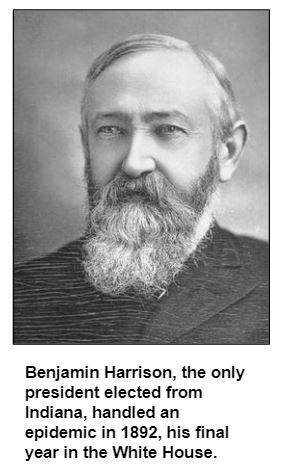
In between phone calls from listeners, Nelson and Charlie will interview each other about an array of topics, including how Benjamin Harrison, the only president elected from Indiana, handled an epidemic in 1892, his final year in the White House. Because of the Covid-19 pandemic, the 1892 cholera epidemic has been the focus of recent articles in the national press.
During our show, Charlie will explain how President Harrison responded when a ship from Hamburg, Germany, one of the epicenters of the epidemic, was en route to the United States. The cholera epidemic began in April 1892 in India and quickly spread to Europe, all while Harrison was dealing with a health crisis in his own family: First Lady Caroline Scott Harrison was gravely ill with tuberculosis and would die later in 1892 in the White House.
In between insights from Charlie and Nelson about this episode and others, listeners are invited to phone the WICR-FM (88.7) studio at 317-788-3314 and pose questions about any aspect of the state's history; typically on Hoosier History Live, questions from listeners are limited to the final 20 minutes of the show.
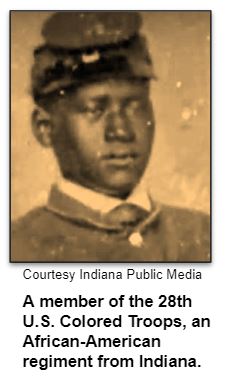
Benjamin Harrison (1833-1901), who became a brigadier general during the Civil War, initiated attempts during his subsequent political career to expand civil rights for African Americans; Charlie will describe these attempts during our show.
Charlie also will discuss the reaction in Indianapolis in 1888 when Harrison, a Republican, was nominated as a presidential candidate. It is the focus of a current exhibit at the presidential site titled The Night Indianapolis Roared.
Another topic during our show will relate to the recent dedication in Carmel of a sculpture and interactive kiosks in honor of Hoagy Carmichael (1899-1981). The famous composer, who grew up in Bloomington and Indianapolis, is profiled in Nelson's book Indiana Legends, 4th edition (Hawthorne Publishing, 2005). Nelson had several interviews with Hoagy's son, Randy Carmichael, who died in 2018; Randy had been a Hoosier History Live guest seven years earlier. The sculpture and kiosks honoring Hoagy are near the Center for the Performing Arts, which includes the Great American Songbook Foundation.
Copyright 2021
|









